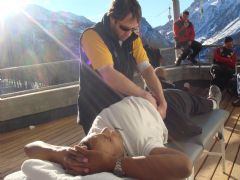Suddenly, lanes at the track have been in heavy demand & those confident in their pre-season training start to swagger, whilst those more reserved about the work they have put in over the winter start to strain & tighten in training, trying to eke out every last perceived bit of a training effect before the early season test exposes their flaws for all to see.
For those of you interested in following how the trials unfold, unfortunately the tickets have now all been sold. Channel 4 will however, be broadcasting live from the EIS Sheffield on Sunday 12th February from 14:00 (or 2pm for those of you not fluent in 24 hour clock speak!!!). For the event timetable, please click on the link below:
Away from the track side, some of the coaches have been continuing their massage therapy training & relative to the topic of sports massage, I came across an interesting abstract of a study published a week or so back, regarding the effects of massage administered after sustaining exercise-induced muscle damage. Now I'll 'fess up & acknowledge that I am not a regular reader of Science Translational Medicine but I was pointed in the direction of the study after results showed that inflammation was reduced & mitochondrial biogenesis (ie. the production of more of the fellas in the cell that turn the fuel into energy, like furnaces in a power station) was promoted.
The single-blind, randomised control study, conducted by Crane et al (2012), from McMaster University in Hamilton (Canada), administered either massage treatment or no treatment to the quads muscles of 11, young, male subjects having sustained exercise-induced muscle damage during a cycle ergometer test to exhaustion. Muscle biopsies were then taken from the vastus lateralis muscle (with the researchers unaware which leg had received the massage intervention) at baseline, after 10 minutes of massage & after 2.5 hours of recovery.
The results showed that the massage promoted a blunting of exercise-induced pain caused by activating similar mechanisms to those triggered by anti-inflammatories (for those of you that are interested, this was by attenuating production of the inflammatory cytokines tumour necrosis factor alpha & interleukin 6, whilst decreasing cellular stress resulting from myofiber injury, by reducing the phosphorylation of heat shock protein 27). In addition, the mitochondrial biogenesis was promoted by the optimised signalling of the receptors responsible (specifically nuclear peroxisome proliferator-activated receptor y co-activator 1 alpha, for all you scientists out there).
The other observation worth noting is that, as has been shown in numerous studies before, the massage treatment did not have any effect on mobilising metabolites (specifically glycogen & lactate) from the muscle tissue. Interestingly, this finding has previously been used to promote the prescription of active recovery, in the form of gentle exercise, in conjunction with massage administered post-exercise, to achieve the desired effect on metabolites. Practically speaking, these results might be used to explain the claim that massage speeds up recovery in athletes sustaining injured muscles, however, it must be remembered that the sample population was small (n=11) & no mention of the athletic capability & training status is made. Furthermore, I can't comment in detail on the study design as I have been unable to lay my hands on the full paper as yet.
To read the abstract for yourself, click on the link below:

